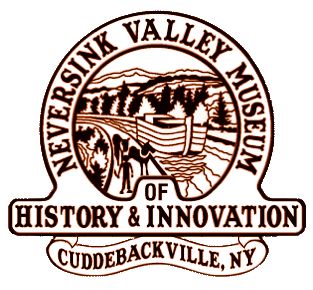Resources
Our collections bring alive the history of the Neversink Valley, the building of the D&H Canal and how life was lived by those who traveled it. But we also have a research library and a collection of silent films made in the area.
Library
The second floor library in the Leura Murray Center is open to all scholars, students and visitors, and has research material including books, magazines, newsletters, maps, photographs and other source material on the D&H Canal and other local history topics. The library is open during Museum hours and other times by appointment.
Delaware & Hudson Canal
Thirty percent of the total collection consists of artifacts relating directly to the D&H Canal. This well-rounded collection of artifacts emphasizes the section of the canal in the Town of Deerpark and includes a large collection of photographs specifically of the section of canal in the D&H Canal Park, other original canal photographs, postcards produced at the turn of the century with local canal scenes, books and other written materials, detailed maps of the canal, letters from Russell Lord, the chief canal engineer, boat passes and broadsides with canal operation information.
Also on display are artifacts from actual canal boats, such as rudders, tillers, a canal boat tool box and bilge pumps. There are numerous canal boat models, three actually made by men who worked on the canal, and one made by an engineer working directly from the canal company specifications for an 1878 boat. Hardware from canal locks and eight foot granite snubbing posts are some of the artifacts from the canal itself. Tools used in building the canal and its boats, such as hammers, picks, digging scoops and caulking hammers tell the story of how the canal was built in only three years, without the use of modern equipment. The Museum is also fortunate to have oral histories and memoirs of people who lived and worked on the canal.
Blacksmithing and Carpentry
Two local trades are represented by twenty percent of the collection, blacksmithing and carpentry. Blacksmiths manufactured hardware for boats and locks as well as shoes for the mules and horses that pulled the boats. Canal boats were built by carpenters, and during this era one lived in what is now the historic Leura Murray Center where the canal exhibition is currently housed. Various blacksmithing tools are displayed in a working blacksmith shop, and other tools which include many different carpentry tools, shoemaker tools and ice harvesting equipment, are currently in collection storage.
Farm Implements
Farming, important in the area in the early 1800’s, is another twenty percent of the collection. Our collection contains farming implements including plows, harvesting equipment, planters, fanning mills, etc.. These artifacts document the change in technology that was so rapid during the 1800’s.
Home Furnishings
Home furnishings and articles make up ten percent of the Museum’s collection. This includes items used in the home such as baskets, dishes, mirrors, textiles and bottles. These artifacts all date from the 1800’s to the 1900’s and relate to the canal and its operation.
Neversink Valley History
The remaining twenty percent of the Museum’s collection includes photographs, stereo-optican cards, written materials, maps and works on paper pertaining to Neversink Valley history from 1800 through 1900. The collection is invaluable in understanding the changes in the area throughout the century, and during the canal’s operation.
Silent Films
The Museum also has a growing collection of silent films made in the area between 1909 and 1912. These films were made by D.W. Griffith during his time with the American Biograph Company and feature stars such as Mary Pickford, Mabel Normand and Mack Sennett. These films used natural scenery, local canal-era buildings, local citizens as extras and views of the D&H Canal as backdrops, and because of this, they are an important historical record. Careful examination of these films have already broadened our knowledge of the canal and other local history topics.
Short Link:
